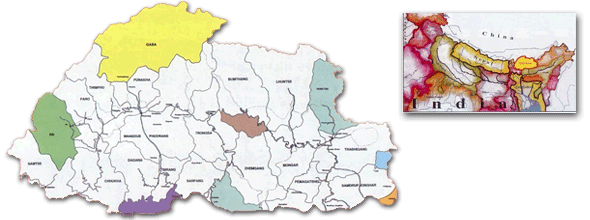Bhutan is a tiny mountain kingdom perched on the eastern Himalayas with an area of approximately 47,000 sq. km. Landlocked, the country is bordered by the Tibet autonomous region of China to the north and by India to the south, east and west. The kingdom has a population of about 600,000. Thimphu, the capital city, has only two residential embassies, those of India and Bangladesh, though the kingdom has established diplomatic relations with a number of countries. As Bhutan enjoys no diplomatic relations with its northern neighbor, all the diplomatic, trade, cultural and economic transactions are conducted with the southern neighbor, India. Bhutan is one of the world’s least developed countries and has an agrarian economy, relying heavily on overseas aid. The bulk of its external aid, about 60 %, comes from India, both in cash and in kind.

The Drukpas, or Ngalongs of Tibetan Mongoloid origin, inhabitant the north-west part of the country. They speak Dzongkha, an offshoot of Tibetan, and they form about 16 – 20 % of the population. The King and the bulk of the ruling oligarchy belong to this community. Sharchops of Indo- Burmese stock predominant in the eastern region and constitute about 30 – 35 % of the population, They speak Shharchopkha, a language similar to the one spoken by the people of Arunachal Pradesh state of India. Nepali speaking people of Indo- Aryan origin live in southern Bhutan and form about 50 – 55 % of the population. While the Drukpas and the Sharchops practice Himalayan Lamaist Buddhism, the southern Bhutanese follow the Hinduism. Besides the three above, there are other ethnic groups and tribes such as Doyas, Brokpas, Adhivashis, Tibetans, Khengs, etc.
Bhutan is ruled under an absolute and hereditary monarchy established, with British involvement, in 1907. The king is both head of state and head of government. There is no written constitution or bill of rights. The judiciary is not independent. There is no provision of defence by qualified attorneys in Bhutan’s courts. The National Assembly of Bhutan represents the ruling feudal elements and does not represent the Bhutanese people. Membership of the National Assembly is not based on universal adult suffrage. The Ministers are appointed by the king and remain in office at the pleasure of the king. The government is not accountable to the people. Political parties and activities are strictly banned in the kingdom. There is no right to free speech and free expression. There is no free press. There is no political rights. There is no right to form associations, unions, or similar associations. There is no right to seek justice. There are no social or cultural rights.
People’s resentment and anger finally exploded in the form of peaceful protests and rallies between September and October 1990. The crackdown on the pro-democracy supporters by police and army led to the flight of several thousand Bhutanese citizens from the south to neighbouring India. The crackdown involved arbitrary arrest and detention, torture, extra-judicial killings, rape, plunder, confiscation of lands, properties and citizenship documents, demolition of houses and forced evictions. The exodus to Nepal began in early 1991 after the government of India failed to provide needed humanitarian relief to the Bhutanese refugees seeking asylum in India. The refugee population rose dramatically after the 70th session of Bhutan’s National Assembly held in October 1991 decided to throw out from Bhutan everyone associated with or involved in the movement for human rights and democracy, including all members of the families of those involved.
The popular demand for political reform, human rights and democracy to replace the current absolute monarchy began after the government controlled by the Drukpas introduced a number of national policies in 1988 directed against the Southern Bhutanese, who were then recognized as forming a majority group in the country. The Citizenship Act of 1985 implemented through a national census in 1988 withdrew the right to nationality from a large section of the southern population. Government legislation requiring every citizen to wear the Drukpa dress, to adopt the Drukpa culture and to learn the Drukpa language violated the social and cultural rights of non-Drukpas. The Green Belt policy to be implemented on the southern border with India had the design of forcibly taking over the ancestral lands of the southern Bhutanese. When the people took to the streets against these policies the government termed the movement “anti-national” and resorted to military means including the mass forced evictions of southern Bhutanese.
Like most modern nations, Bhutan’s 650,000 people consist of several ethnic groups. The Ngalongs of the western mountains and the central Bhutanese with whom they have intermarried form the elite, but they constitute a minority alongside the more numerous Sharchhops (‘easterners’) and Lhotshampas (‘southerners’ or ‘Nepali-speaking Bhutanese’). Almost all of the refugees come from this last group, which before the crisis began was reckoned to constitute between one third and one half of the total population.
